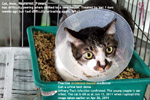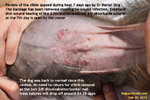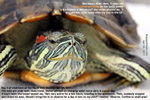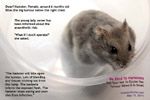Today I had a meeting with the young couple from 9.40 am to 11.30 am as the young couple wanted answers as to why their 8-year old neutered male cat had died during treatment at Vet 2 which was associated with a veterinary surgery of Vet 1.
The cat had an inflamed penis and difficulty in peeing and in the opinion of the owners, should not have died based on this medical condition. It was a reasonable deduction and the husband had emailed me informing me of the cat's death as I had treated him in April and November 2011for Feline Lower Urinary Tract Disease (FLUTD). This case is reported in FLUTD
Basically, XXX had a relapse of FLUTD and the couple had sent him to Vet 1 for treatment, owing to proximity of location.
Answers were wanted as Vet 2 had performed an autopsy and said that the cause of death was unknown.
"Could it be anaphylaxis or allergy to cefloxalin given together with the calcium in the IV drip?" the wife wanted to know as she had researched the internet and there was information on the adverse drug reactions using the combination, in human beings.
"It is very
difficult to ascertain that the drugs had caused his
death," I said as the owner had described that the cat
was discharged home in a stoned state, being unable to
stand or walk normally and then had pale gums and
breathing difficulty in the evening. The cat was
rushed to Vet 2 around midnight and he passed away
despite X-rays and treatment. "Adverse drug reactions
in people may not apply to the cat and vice versa."
So, what was the cause of death? The couple had spoken
to the proprietor of the surgery but was no wiser.
They showed me the medical records and 2 X-rays taken
before death. One lateral X-ray showed black air
inside the lung. The V/D X-ray showed that the lungs
and chest area were opaque. It was hard to explain
why.
The blood test showed a low platelet count.
Low platelet count. I discussed the case later
with Dr Daniel who said that the cat have died of
internal bleeding leading to or as a result of low
platelet count. It was plausible. For example,
traumatic injury to the lung (lung bleeding was
reported in the autopsy) due to the "feisty" cat being
nursed and changing of the litter, catheter and
urination bag etc.
But the low platelet count by itself would not have
killed this cat as I have had seen such cases of lower
platelet count in toxaemia and tick fever and the dogs
survived.
"In any case, an autopsy done by the same practice
would not be credible as there was a conflict of
interest," I said. "An independent veterinary body
ought to have done the autopsy." The owner was not
aware of the need for this procedure.
Vitamin C dosage The cat was given high doses
of Vitamin C daily by IV during the 5-day
hospitalisation. "This practice believes in high doses
of Vitamin C in treatment," I said. "Whether the
dosage killed this cat, it is hard to determine."
Sedation - valium and ketamine IV during
hospitalisation. Would the daily IV injection to
sedate the cat for ease of handling and changing of
the litter cause death by cumulative dosage in an old
cat that was already stressed out and frightened? I
believe it would but Dr Daniel disagreed. This would
account for the owner's observation that the cat could
not lift up his head, that his eyes could not track
finger movement and that after the 2nd day of
hospitalisation, the cat looked "stoned" and could not
even give a soft meow as usual.
"Why would the vet discharge a cat when he was not
well?" the wife asked me.
"It could be that the cat would be better nursed at
home," I said. "Since the cat was feisty (aggressive),
it would be very difficult for the nurses to nurse and
clean him. In the first place, this cat could have
been better nursed at home. Vet 1 had proposed home
nursing with the catheter inside the bladder.
Struvites were reported and this would be much better
to manage at home for a ferocious cat.
I can't figure out why the owner did not consult me
after Vet 1's treatment was unsatisfactory in their
opinion. This was what they did in April 2011 and then
in November 2011. Proximity to Vet 1 was the reason
given for this time-pressed couples.
"I would not go to the same car mechanic near my house
if I know that he had not repaired my car to my
satisfaction," I said frankly to the couple as they
were the type who wanted answers to a death of the cat
for knowledge and prevention and not for litigation.
We could converse frankly rather than beat around the
bush. "For car in bad state, it would be for safety
reasons. For a pet, it could be a matter of life and
death."
It was difficult to find the correct answers to this
cause of death. I believe it was the cumulative
effects of sedation. I could imagine that another dose
of sedation was given (as stated in the records) every
day as the cat showed ferocity when the litter was
changed daily or frequently. There was the urinary bag
attached to the catheter to be changed. Medical
records stated the cat was "feisty" on two days and so
sedation had to be given.
"What should we do if we have a cat?" the wife asked.
"Get a female cat," I said. "FLUTD is less likely in a
female cat. For male cats or dogs with struvite
urinary stones, a monthly urine test and 3-monthly
X-rays for pets with struvite urinary stones is
advised. But no cat owner will comply."
 "Did
you follow my instructions that the cat should not
be given treats?" I asked. "I had recorded 'no
treat' in the blood test result too."
"Did
you follow my instructions that the cat should not
be given treats?" I asked. "I had recorded 'no
treat' in the blood test result too."
The cat was given canned C/D diet after 2 months of
S/D diet since April 2011 when the couple had
consulted me.
"Well, 2 weeks before consulting Vet 1 in February
(2012), I did give him dental treats."
"This should not be given," I said. "Struvites could
be formed as a result and this lead to urination
difficulty and an inflamed penis."
"The penis was inflamed because the tip of the penis
had been bitten off," the wife said. "You were the one
who told us in April 2011. Do you remember? You
extracted the broken canine tooth as that could be the
cause of irritation and injury. So his penis was
diagnosed 'inflamed' by Vet 1 but it was due to the
fact that he had no tip."
Owners who love their pets very well remember all
treatments like elephants as their pets are family. "I
remember Tobi for his hissing at me," I said. "He did
not like vets. Did you give other treats as well?"
"Some love letters, as it was Chinese New Year," the
wife recalled.
"Some, but not all cats and dogs with a history of
struvites in their urine cannot eat other food as the
problem will come back to cause peeing difficulty," I
said. Her cat was one of this category. If the owner
gives a strictly controlled diet, usually there is no
problem.
 It
was a sad day and I hope that the couple had received
some answers as everyone learns from experience. There
is no other way. Reading widely on your pet's health
problems may give insights and knowledge of what had
happened to other people's pet and thereby instituting
preventive measures to ensure that your pet's health
is optimal. For example, dental scaling to keep the
teeth and mouth free from infection, enabling the cat
to eat well and without pain. Cats need to groom
themselves and therefore clean teeth without
periodontal diseases are more important to them as
compared to the dog.
It
was a sad day and I hope that the couple had received
some answers as everyone learns from experience. There
is no other way. Reading widely on your pet's health
problems may give insights and knowledge of what had
happened to other people's pet and thereby instituting
preventive measures to ensure that your pet's health
is optimal. For example, dental scaling to keep the
teeth and mouth free from infection, enabling the cat
to eat well and without pain. Cats need to groom
themselves and therefore clean teeth without
periodontal diseases are more important to them as
compared to the dog.
Proximity to the vet surgery is convenient but
sometimes, it is best to find a vet that can handle
your pet's more complex health problems. A practice
that has different doctors attending to your pet may
not be in the interest of your pet. However the same
vet treating your pet may not be suitable and a second
opinion may be needed if the outcome of treatment is
not to your satisfaction.
P.S. In a recent liposuction death case in
Singapore, the patient was given more IV anaesthetic
as he moved during liposuction. He died not long after
the end of the liposuction procedure. On autopsy, 13
intestinal perforations were found. However, these
were not said to be the cause of death. The IV
anaesthetic given in more and more doses as the
patient moved was said to cause him to die from
asphyxiation as he could no longer breathe normally.
The cause of death was said to be over-sedation with
propofol.
 TOA
PAYOH VETS
TOA
PAYOH VETS





